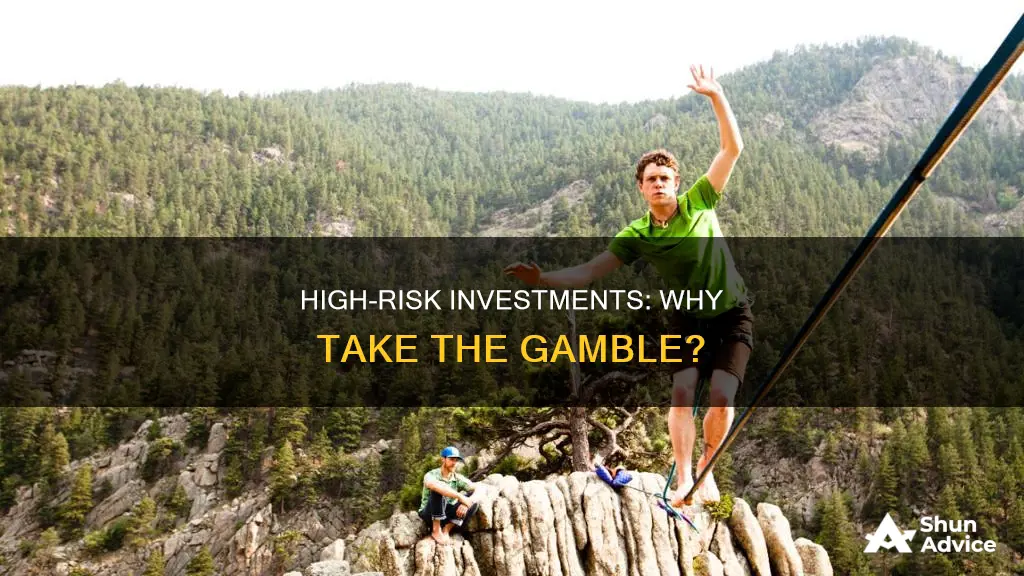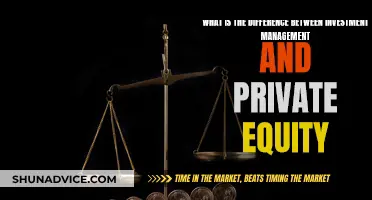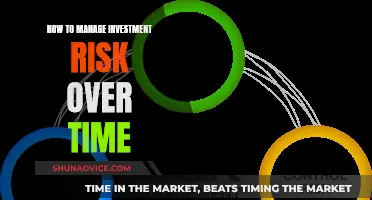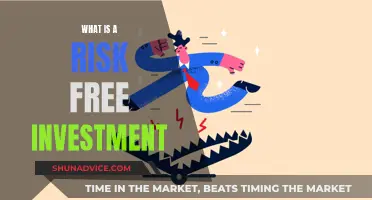
High-risk investments are those with a large percentage chance of loss of capital, under-performance, or a high chance of a devastating loss. While there is no guaranteed way to double your money with any investment, high-risk investments may offer the chance of higher returns than other investments, but they put your money at higher risk. This means that if things go well, high-risk investments can produce high returns, but if things go badly, you could lose all of the money you invested.
| Characteristics | Values |
|---|---|
| Returns | Bigger returns |
| Risk | Higher chance of losing most, if not all of your capital/assets |
| Pros | High returns can help you build your wealth faster and achieve your investment goals. They can also help you keep up with inflation. |
| Cons | The uncertainty and unpredictability of these investments may pose too much uncertainty, and a greater chance of losing value. |
| Investor Type | Experienced investors |
| Investor Mindset | Prepared to potentially lose all of what you invested. Only invest what you can afford to lose. |
| Investor Action | Be wary of scams and trade on a trusted platform. |
| Investor Action | Check that your investment will be covered by the Financial Services Compensation Scheme (FSCS). |
| Investor Action | Get financial advice from an independent advisor if you’re unsure or need help investing. |
| Investor Action | Only make high-risk investments part of a balanced, diverse portfolio. |
What You'll Learn

High-yield, high-risk
High-risk investments can be attractive, offering the potential for high returns. However, it's important to remember that these investments are not without their drawbacks and potential pitfalls.
High-risk investments are those that carry a significant chance of losing all or part of the initial investment. These investments often have lower levels of liquidity, meaning that it can be difficult to access your money if you change your mind. They are also more volatile and unpredictable, and in some cases, they may lack regulatory protection.
Things to remember for high-risk investing:
- High-risk investing is generally only suitable for experienced investors.
- While potential returns are higher, potential losses are also greater.
- Don't invest more than 10% of your net assets in high-risk ventures.
- Be prepared to lose all of your investment.
- Only invest what you can afford to lose.
- Be wary of scams and only trade on trusted platforms.
- Check that your investment is covered by financial services compensation schemes.
- Seek financial advice from an independent advisor if you're unsure.
Examples of high-risk investments:
- Initial Public Offerings (IPOs)
- Venture Capital Trusts (VCTs)
- Foreign Emerging Markets
- Real Estate Investment Trusts (REITs)
- High-yield bonds
- Currency trading
- Crypto assets
- Mini bonds or corporate bonds
- Spread betting
- Contracts for Difference (CFDs)
- Land banking
Managing high-risk investments:
While it's not possible to remove risk entirely, you can manage it by trading responsibly and with caution. You can also choose your level of direct involvement, from hands-on management to passing decision-making over to a trusted provider.
High-risk vs low-risk investments:
The choice between high-risk and low-risk investments depends on your investment goals and attitude to risk. High-risk investments offer the potential for bigger rewards, while low-risk investments are generally less volatile and more predictable. A balanced portfolio should include a mix of both to spread the risk and soften the impact of market fluctuations.
Factors affecting risk:
- Investment time frame: Longer-term investments have more time to recover from fluctuations and losses.
- Income: If you rely on your income for immediate needs, investing may not be for you.
- Risk tolerance: Consider how comfortable you are with the idea of your investment losing value.
- Capacity for loss: Your disposable income will affect how much risk you're willing to take on.
- Economic factors: Keep an eye on the economy, including inflation and interest rates, when preparing your investment strategy.
- Global events: Unpredictable events like political instability, pandemics, and weather catastrophes can impact financial markets and investments.
Types of investment risk:
- Interest rate risk: Unexpected changes in interest rates can affect the value of an investment, particularly bonds.
- Inflation risk: Inflation reduces the buying power of money, affecting the real returns on investments.
- Capital risk: The chance of losing all or part of an investment, which applies to most investment types.
- Market risk: Political and macroeconomic factors that can impact an entire economic market or a large part of it.
- Business risk: The viability of a commercial operation, including its ability to generate revenue and cover operational expenses.
- Credit risk/default risk: The potential for a borrower to default on debt obligations, a concern for investors holding bonds.
- Political risk: The possibility of an investment losing value due to political changes or instability.
Managing risk:
- Keep a long-term focus: The longer you invest, the more chance your investments have to recover from market downturns.
- Diversify your portfolio: Spread your investments across different options to minimise the impact of any single risk.
- Break up your investments: Invest smaller amounts regularly to smooth out the peaks and dips created by market volatility.
High-risk investing mistakes to avoid:
- Believing guarantees: There is no guaranteed return on investment without some level of risk. Be critical and do your research to avoid scams.
- Committing too quickly: Take time to assess your options and don't be rushed by limited-time offers.
- Not checking regulation: Even if an investment is high-risk, look for ones that have some protection. Check for regulation by relevant financial authorities.
- Not seeking financial advice: High-risk investments are not a decision to be taken lightly, especially for beginners.
- Only making high-risk investments: Mitigate risks by diversifying your portfolio and spreading your investments across different levels of risk.
In conclusion:
High-risk, high-yield investments can be a valuable part of a balanced and diverse portfolio. However, it's important to carefully consider your risk tolerance, investment goals, and financial situation before committing. Remember that there are no guarantees, and even experienced investors can lose money in high-risk ventures.
A Beginner's Guide to Mutual Fund Investing in India
You may want to see also

Potential for big payouts
High-risk investments can lead to bigger returns, although there is a higher chance of losing most, if not all, of your capital/assets.
Pros:
High returns can help you build your wealth faster and achieve your investment goals. They can also help you keep up with inflation.
Cons:
The uncertainty and unpredictability of these investments may pose too much uncertainty and a greater chance of losing value.
Factors to consider:
- Income – If you are relying on your income for immediate needs, then investing may not be for you. Your income can also determine your risk capital, which is the amount of money you are willing to trade or invest without affecting your lifestyle.
- Time horizon – The longer your investment horizon, the greater the risk you can afford to take as you have more time to recover from market downturns.
- Risk tolerance – Some people may feel less comfortable with the idea of their investment losing value. Others might be more willing to accept that in pursuit of greater returns.
Common types of high-risk investments:
- Initial Public Offering (IPO) – When a private company changes to a public company and offers shares to the public for the first time.
- Venture Capital Trusts (VCTs) – VCTs specialise in funding smaller, new businesses to help growth in their early stages.
- Foreign Emerging Markets – Investments within developing nations with perceived growth opportunities as their markets develop.
- Real Estate Investment Trusts (REITs) – REITs operate similarly to an investment trust and use investor funds to own and operate properties to generate income.
- High-yield bonds – Bonds that have ‘low-quality’ ratings but promise to pay out higher rates of interest due to the increased level of risk.
- Currency trading – Involves buying one type of currency while selling another currency at the same time.
- Crypto – Crypto assets are purely digital and non-tangible, very volatile, and mostly unregulated in the UK, so your investments may not be protected.
Tips for high-risk investing:
- High-risk investing should only be done by experienced investors.
- Don’t put more than 10% of your net assets in high-risk investments.
- Be prepared to potentially lose all of what you invested.
- Only invest what you can afford to lose.
- Be wary of scams and trade on a trusted platform.
- Check that your investment will be covered by the Financial Services Compensation Scheme (FSCS).
- Get financial advice from an independent advisor if you’re unsure or need help investing.
Savings and Investments: Strategies for Success in Lean Times
You may want to see also

Risk of losing all your money
Risk is inherent in any investment, and the possibility of losing all your money is a very real danger. However, the risk of total capital loss varies depending on the type of investment.
Types of Investment Risk
Firstly, it is important to understand the different types of investment risk. These include:
- Interest rate risk: The value of an investment can change due to unexpected fluctuations in interest rates. This type of risk tends to affect bonds more than stocks.
- Inflation risk: The potential loss of buying power due to a rise in the prices of goods and services, which can lead to a decrease in purchasing ability.
- Capital risk: The chance of losing all or part of an investment, especially when there is no guarantee of a full return.
- Market risk: Risks that can impact an entire economic market or a large part of it, such as political and other macroeconomic factors.
- Business risk: The viability of a commercial operation, focusing on whether a business can generate sufficient revenue to cover operational expenses and turn a profit.
- Credit risk/default risk: The potential of a borrower defaulting on principal or interest payments. This is often a concern for investors holding bonds.
- Political risk: The risk of an investment losing value due to political changes or instability.
Factors Affecting Risk
There are several factors that can affect the level of risk associated with an investment:
- Time horizon: The longer an investment is held, the more time it has to recover from fluctuations in value. Therefore, a higher-risk investment may be better suited to a longer time horizon.
- Income: If the money you are investing is needed for immediate needs, investing may not be the best option.
- Risk capacity: The amount of financial risk you can take on given your current financial situation. This depends on factors such as your net worth, disposable income, and liabilities.
- Economic factors: Keeping an eye on the broader economy, including factors such as inflation and interest rates, can help when weighing the potential benefits and risks of an investment.
- Global events: Unpredictable global events, such as political instability, pandemics, and weather catastrophes, can have a significant impact on financial markets and investments.
Managing Risk
While it is impossible to eliminate investment risk, there are strategies to help manage and mitigate it:
- Long-term focus: Holding investments for the long term can help ride out the ups and downs of the market.
- Diversification: Spreading your investments across different options, such as stocks, bonds, cash, mutual funds, and exchange-traded funds (ETFs), can help reduce the impact of market volatility.
- Pound-cost averaging: Investing smaller amounts regularly can smooth out the peaks and dips created by market volatility.
High-Risk Investments
High-risk investments can lead to bigger returns but come with a higher chance of losing most, if not all, of your capital. Examples of high-risk investments include:
- Initial public offerings (IPOs): These can be risky due to the uncertainty surrounding the performance of a newly public company.
- Venture capital: Investing in startups is risky due to the high failure rate, but it can offer high returns if the startup succeeds.
- Foreign emerging markets: Investing in countries experiencing high economic growth can be lucrative, but the period of extreme growth may be shorter than expected, leading to disappointing performance.
- Real estate investment trusts (REITs): These offer high dividends but also come with a high risk of losing the initial principal investment.
- High-yield bonds: These offer high returns but may be "junk" bonds with a high risk of default.
- Penny stocks: Stocks sold for $5 or less per share can be risky due to their lack of liquidity and market volatility.
Weighing the Risks and Rewards
When considering high-risk investments, it is essential to weigh the potential rewards against the possibility of losing all your money. While there is no guaranteed way to double your money, some high-risk investments can potentially provide high returns. However, for every successful investment, there are hundreds that fail. Therefore, it is crucial to carefully assess your risk tolerance, time horizon, and financial capacity before making any investment decisions.
India's Green Energy Investments: Where is the Money Going?
You may want to see also

Lack of regulatory protection
High-risk investments can be enticing due to the possibility of substantial financial gains. However, it is crucial to recognise that these investments often lack regulatory protection, which can significantly impact investors' financial security.
Regulatory bodies, such as the Securities and Exchange Commission (SEC) in the United States and the Canadian Investment Regulatory Organization (CIRO) in Canada, play a vital role in safeguarding investors' interests. They establish and enforce rules to ensure fair and transparent practices in the securities industry. However, high-risk investments may fall outside the scope of these regulations, leaving investors vulnerable to potential losses without regulatory recourse.
In the case of mutual funds, for example, the SEC requires registration and oversight only if the fund manages assets of $100 million or more or provides investment advice to a company registered under the Investment Company Act of 1940. High-risk investments that fall below these thresholds may not be subject to the same regulatory scrutiny, increasing the risk for investors.
Additionally, regulatory protection may vary depending on the specific type of investment and the jurisdiction in which it is offered. For instance, in Canada, provincial and territorial securities regulators, such as the Ontario Securities Commission (OSC), set the standards for market intermediaries dealing with investors. However, these standards may not cover all high-risk investments, and investors must be diligent in understanding the regulatory landscape before committing their capital.
The lack of regulatory protection in high-risk investments means that investors bear a higher risk of financial loss. Without regulatory oversight, there is less assurance that the investment is legitimate and secure. It also means that investors have limited recourse if issues arise, as regulatory bodies may not have the authority to intervene or enforce investor protections.
Therefore, when considering high-risk investments, it is crucial for investors to conduct thorough due diligence, understand the regulatory landscape, and carefully assess their risk tolerance and financial capacity. While the potential for significant gains exists, the absence of regulatory protection underscores the heightened risk associated with these investments.
Understanding Timberland Investment Management Organizations: A Guide
You may want to see also

Volatility and market confidence
Market confidence is a factor that influences volatility. When market confidence is high, investors are more likely to tolerate risk and volatility. Conversely, when market confidence is low, investors may be more cautious and averse to risk.
It is important to differentiate between risk and volatility. Risk pertains to the possibility of an investment yielding a different outcome than expected, especially a loss. Volatility, on the other hand, measures the intensity and frequency of price changes over time. A highly volatile market is characterised by significant price fluctuations, while low volatility indicates more stable prices.
While the two concepts are distinct, they are often lumped together because volatile markets tend to be riskier. This is because, intuitively, if the value of a financial security moves up and down more frequently, it is more likely to experience a bigger loss over the same time span as a less volatile security.
However, it is worth noting that volatility is not always a good measure of risk. Volatility only accounts for price differences and does not consider the probability of underperformance or actual losses. Risk, on the other hand, takes into account a wider range of factors, such as credit risk, liquidity risk, and market risk.
When considering a high-risk investment, it is crucial to assess both the risk and volatility inherent in the investment opportunity. This involves analysing historical performance, comparing it to broad-based market indicators, and considering the impact of economic and market conditions.
By understanding the relationship between volatility and market confidence, investors can make more informed decisions about high-risk investments and navigate risky and volatile markets with confidence.
Investment Management: Choosing the Right College Major
You may want to see also
Frequently asked questions
High-risk investments may offer the chance of higher returns than other investments, but they put your money at higher risk. If things go well, high-risk investments can produce high returns.
Some examples of high-risk investments include:
- Initial Public Offerings (IPOs)
- Venture Capital
- Real Estate Investment Trusts (REITs)
- Foreign Currency
- Penny Stocks
- Cryptocurrency
The main risk of high-risk investments is that you could lose all the money you invest. Other risks include a lack of protection if things go wrong, difficulty accessing your money, and reduced value of your investment due to the issuance of more shares by the business.







